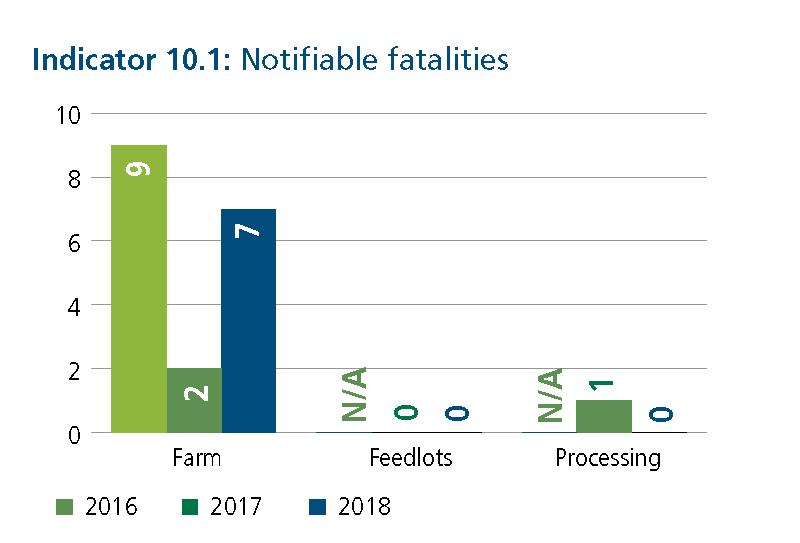Health & safety of people in the industry
Working environments vary considerably between farms, feedlots and processors. Within the industry, work health and safety procedures, practices and incident rates differ significantly by sector. As a whole, agriculture is one of Australia’s most dangerous industries to work in, making up 2.3% of our workforce, but accounting for 20% of worker fatalities.
Australia’s red meat processing sector has well-established work health and safety procedures, systems and practices to protect its workforce.
For feedlots, work health safety is managed within the National Feedlot Accreditation Scheme (NFAS). For livestock transporters, the Australian Trucking Association’s TruckSafe scheme sets out standards for driver health and safety.
Farms are unique business environments. Producers face the highest risk to life across the industry – managing plant, chemicals, noise, dust, sun exposure, animals, and – for many – solitary work or work in remote locations. Additionally, farms are often both workplaces and residences, which can leave family members exposed to hazards. Cattle, sheep and grain farming account for the highest numbers of fatalities in agriculture. Safe Work has identified agriculture as a priority industry in its Work Health and Safety Strategy 2012-22.
Industry position
The Australian red meat and livestock industry prioritises the wellbeing of people and has a zero-harm policy for any individuals within the supply chain.
The industry supports policies that incentivise businesses across the supply chain to improve work health and safety.
What is the data telling us?
On-farm fatalities saw an increase in 2018 compared to the previous year however is still trending down from the 2016 baseline. Positively there were no notifiable fatalities in processing. Currently data for the feedlot sector is not available.
Snapshot of activity
The considerable differences in the risks between sectors requires a tailored approach to tackling health and safety.
Processing
It is a legal requirement for individual companies to provide safe workplaces, and report any incidents. Processors invest in their own work health and safety programs to reduce the inherent risks of processing meat.
At an industry level, the Australian Meat Industry Council (AMIC) maintains a substantial body of health and safety resources for members. These include guidelines, publications, risk management guides, injury management procedures, training videos and tutorial guides. AMIC is undertaking a project with Deakin University to more accurately understand the causes of injury in meat processing, and calculate lost time from injuries.
The Australian Meat Processor Corporation (AMPC) is currently investing $3.15 million into an industry capability program. This includes workplace safety and ergonomics projects, and $0.81 million for vocational training, including professional development and maintenance upskilling.
Feedlot
For feedlots, work health and safety is managed within the National Feedlot Accreditation Scheme (NFAS). NFAS requires feedlots to ensure that “staff are adequately trained to ensure they have the appropriate skills and knowledge to competently perform the duties required of them by the NFAS standards”.
In July 2019, the Australian Lot Feeders’ Association will conduct a series of workshops for feedlots in which participants will learn to promote effective team communication, which is vital to keeping everyone safe in environments filled with rapid change. The one-day workshop is designed for all personnel but has been tailored specifically for feedlot staff, with practical references to their on-site work environment.
On farm
Research and Development Corporations (RDC) including AgriFutures, Dairy Australia and MLA have partnered to form the Rural Safety and Health Alliance (RSHA). From late 2019, the RSHA is driving cross-sectoral collaboration on research, development and adoption (RD&A) initiatives. RD&A activities aim to reduce death, injury and illness, and enhance health and wellbeing in Australian agriculture.
The NFF aspires for zero farm fatalities by 2030. The NFF works with a number of farm safety initiatives to develop tools and ensure a culture of safety in the industry, and seeks to “close the gap between the psychological wellbeing of producers and the broader community”.
NSW Producers has secured funding from SafeWork NSW to deliver the Farm Safety Advisory pilot program. The program helps businesses analyse where they currently sit in regard to Work Health and Safety (WHS), and develop a WHS program that is custom fit for the business. The program includes face-to-face meetings with Farm Safety Advisor Charles Laverty, and aims to reduce risk for all members of the farm.
NFF and Safe Work Australia partner to produce videos showcasing best practice in health and safety on the farm. MLA has created a series of online resources that include checklists, templates and guidelines to help beef producers plan and implement health and safety initiatives. The FarmSafe Australia Safety Induction Tool is an easy-to-use online guide that can be used by farm managers to induct and train new workers in farm safety.
Mental health
Many farmers find the work they do rewarding and fulfilling. However, farmers also face many pressures that are out of their control such as drought, natural disasters and trade shocks. When prolonged, these pressures, coupled with the isolation of rural life, can have a real impact on the mental health and wellbeing of farmers and farming families. This fact became even more relevant in the midst of the COVID-19 pandemic.